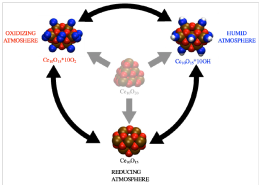CHEMISTRY AND STRUCTURE OF OXIDE SURFACES AND NANOPARTICLES
WG3 members: Kersti Hermansson, Peter Broqvist, Matti Hellström, Matthew Wolf
homepage: www.teoroo.kemi.uu.se
The Teoroo (theoretical inorganic chemistry) group at Uppsala University employs a wide range of theoretical methods to explore and explain physical and chemical phenomena involving surfaces and nano-particles of CeO2, TiO2 and ZnO. Ab initio and semi-empirical quantum mechanical methods, and classical (reactive) force fields, are used, often as part of a multi-scale simulation strategy.
In recent work, we have addressed:
- The possible misidentification of F impurities as oxygen vacancies at CeO2 [Phys. Rev. Lett. 112, 156102 (2014],
- The dependence of the charge state of Cu clusters on ZnO(101̅0) on the number of atoms in the cluster [J. Phys. Chem. C 118, 6480–6490 (2014)], and
- The adsorption, motion and dissociation of formic acid (HCOOH) molecules on rutile TiO2-x(110) [J. Phys. Chem. C 118, 6480–6490 (2014)].
- We also have an ongoing interest in understanding the low-temperature reactivity of CeO2 nanoparticles, see for example [Proc. of SPIE 8822 88220D-1 (2013)], where we examined how oxidative and humid environments affect the chemical composition, shape and structure of striciometric and reduced CeO2 nanoparticles (see the figure).



